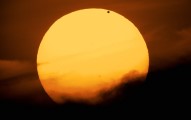Hola,
para quien le interese, hay una nueva alerta interesante de la AAVSO, donde piden fotometría de una estrella bastante especial, una de las raras subenanas azules que están siendo estudiadas por unu grupo de Dublín. Piden fotometría de alta cadencia (unos 60" por pose) de esta estrella. Preferiblemente poses seguidas en los filtros B y V de Johnson (secuencia BVBVBVBV....) y si eso no es posible o tememos machacar la rueda portafiltros, centrarse en el filtro B de Johnson.
El período de observación comienza ya (bueno, ya ha comenzado) y se extiende hasta el 2 de setiembre.
No es un objeto fácil. Es de mag. 13 y presenta un índice B-V negativo, es decir, es una estrella muy azul. Si a eso añadimos que presenta una baja declinación (sec Z>2 durante casi toda la visibilidad), será difícil obtener buena fotometría. Yo lo intenté anoche, pero el mal cielo, unido a que el sistema que usaba no era el mejor (un 20 cm es quizás muy justo en estos cielos malos y la Atik 314L+ no es la ST8), me hizo desistir por la pésima fotometría que salía (+/- 0.04 mag.). Quieren tener un mínimo de 10000 ADU's en la variable siempre que no sature la comparación (evitar las comparaciones con elevado B-V como la 112) aunque aquí lo correcto sería hablar de una S/N lo más alta posible, 50 como mínimo o algo así.
Las sesiones fotométricas deberían durar al menos dos horas.
Transcribo la alerta entera.
Suerte con las observaciones. La semana que viene parece apuntar bien, aunque la Luna... ![]()
Saludos
Fran
+++++++++++++++++++++++++++++++++
AAVSO Alert Notice 526
August 20, 2015
Monitoring of LS IV -14 116 in support of upcoming satellite observations
Prof. Simon Jeffery (Armagh Observatory; Trinity College Dublin)
has requested photometric monitoring of the pulsating helium and
zirconium-rich hot subdwarf LS IV -14 116 in support of upcoming
HST and VLT/UVES spectroscopy. AAVSO observations will supplement
photometry due to be obtained with the SAAO 1.0-m and IAC 0.8-m
telescopes from 18 August to 2 September 2015. Photometry is
requested beginning immediately through 2 September.
LS IV -14 116 is magnitude V=13.0 and B=12.6. Prof. Jeffery writes:
"The star shows at least 5 independent pulsation frequencies. The
objective of these observations is to resolve the frequencies, to
measure their amplitudes, and also to measure the amplitude of any
colour variations, so as to set the high-resolution spectroscopy
and ultraviolet spectrophotometry into context.
"Requirements are:
i) at least one of Johnson B and V filters (both if available, cycled
BVBVB..., and/or BVRBVR... or BVIBVI...)
ii) 10,000 target counts per frame (for LS IV-14 116, unless bright
comparison is saturated and no other good comparisons in field). The
10,000 counts requirement is indicative rather than a minimum, and
exposures of up to 100 s are acceptable, so long as the overall
cadence provides a data point in each filter every 300 s (5 minutes)
or less. The shortest period exhibited by the star is 1950 s, which
we would like to sample well.
iii) exposures times 60 seconds or less (per filter)
iv) timestamps on image frames to be precise and regularly checked
against GPS or other external clock
v) minimum useful runs: 2 hours; data obtained over long runs and
several nights is preferred
vi) useful dates: 19 August to 2 September
"...If AAVSO observers prefer not to exercise their filter wheels
all night, then continuous photometry in just the B-band would be
acceptable. I am conscious that many filter wheels for the commercial
market are not very robust (we have one in Armagh!). We can deduce
the colour amplitudes from fewer sites, but refining the window
function for the B data would be really good."
For some general background on this fascinating type of star, see:
https://dl.dropboxusercontent.com/u/751 ... 2.32-5.pdf
Coordinates: RA 20 57 38.88 Dec -14 25 44.0 (J2000)
Finder charts with comparison stars for LS IV -14 116 may be created
using the AAVSO Variable Star Plotter (VSP, https://www.aavso.org/vsp ).
A photometry table is also available via VSP.
For those using CCD chips with a small field of view, Prof. Jeffery
requests the comparison stars TYC 5782-1367-1 and 2MASS J20574148-1426122
(labeled 112 and 147, respectively, in the AAVSO sequence). However,
observers whose CCD chip has a larger field of view are urged to use
comparison stars other than the 147 because that star is very red and
the target is blue. Also, observers using the 112 in particular are
cautioned to beware of saturating this comp star.
Please report observations to the AAVSO International Database using
WebObs and the name "LS IV -14 116". Be careful to include all the
spaces in the name as shown.
This AAVSO Alert Notice was compiled by Elizabeth O. Waagen.
----------------------------------
SUBMIT OBSERVATIONS TO THE AAVSOAAVSO Alert Notice 526
August 20, 2015
Monitoring of LS IV -14 116 in support of upcoming satellite observations
Prof. Simon Jeffery (Armagh Observatory; Trinity College Dublin)
has requested photometric monitoring of the pulsating helium and
zirconium-rich hot subdwarf LS IV -14 116 in support of upcoming
HST and VLT/UVES spectroscopy. AAVSO observations will supplement
photometry due to be obtained with the SAAO 1.0-m and IAC 0.8-m
telescopes from 18 August to 2 September 2015. Photometry is
requested beginning immediately through 2 September.
LS IV -14 116 is magnitude V=13.0 and B=12.6. Prof. Jeffery writes:
"The star shows at least 5 independent pulsation frequencies. The
objective of these observations is to resolve the frequencies, to
measure their amplitudes, and also to measure the amplitude of any
colour variations, so as to set the high-resolution spectroscopy
and ultraviolet spectrophotometry into context.
"Requirements are:
i) at least one of Johnson B and V filters (both if available, cycled
BVBVB..., and/or BVRBVR... or BVIBVI...)
ii) 10,000 target counts per frame (for LS IV-14 116, unless bright
comparison is saturated and no other good comparisons in field). The
10,000 counts requirement is indicative rather than a minimum, and
exposures of up to 100 s are acceptable, so long as the overall
cadence provides a data point in each filter every 300 s (5 minutes)
or less. The shortest period exhibited by the star is 1950 s, which
we would like to sample well.
iii) exposures times 60 seconds or less (per filter)
iv) timestamps on image frames to be precise and regularly checked
against GPS or other external clock
v) minimum useful runs: 2 hours; data obtained over long runs and
several nights is preferred
vi) useful dates: 19 August to 2 September
"...If AAVSO observers prefer not to exercise their filter wheels
all night, then continuous photometry in just the B-band would be
acceptable. I am conscious that many filter wheels for the commercial
market are not very robust (we have one in Armagh!). We can deduce
the colour amplitudes from fewer sites, but refining the window
function for the B data would be really good."
For some general background on this fascinating type of star, see:
https://dl.dropboxusercontent.com/u/751 ... 2.32-5.pdf
Coordinates: RA 20 57 38.88 Dec -14 25 44.0 (J2000)
Finder charts with comparison stars for LS IV -14 116 may be created
using the AAVSO Variable Star Plotter (VSP, https://www.aavso.org/vsp ).
A photometry table is also available via VSP.
For those using CCD chips with a small field of view, Prof. Jeffery
requests the comparison stars TYC 5782-1367-1 and 2MASS J20574148-1426122
(labeled 112 and 147, respectively, in the AAVSO sequence). However,
observers whose CCD chip has a larger field of view are urged to use
comparison stars other than the 147 because that star is very red and
the target is blue. Also, observers using the 112 in particular are
cautioned to beware of saturating this comp star.
Please report observations to the AAVSO International Database using
WebObs and the name "LS IV -14 116". Be careful to include all the
spaces in the name as shown.
This AAVSO Alert Notice was compiled by Elizabeth O. Waagen.
----------------------------------
SUBMIT OBSERVATIONS TO THE AAVSO
Meade LX200 12" Classic. Autoguiado Orión 80/400 + QHY6.
Newton Larrosa 200 f/4.7 sobre HEQ5 Syntrek. Autoguiado Orion Miniguider 50/162 + ASI 120 MM
Skywatcher 150mm f/5 sobre EQ5
Cámaras: SBIG ST-8XME para fotometría y postaleo
Atik 314L+ para postaleo y fotometría
ASI 120 MM para planetas y autoguiado
Filtros Astrodon BVRcIc (Johnson-Cousins) + rueda SXUFW-1T2
Prismáticos Vixen 7x50, ordenatas, cobertizo casero y otras cosicas...
Gracias por el aviso Fran, pena que solo tengo el filtro V, pero todo llegar´a.
A ver si el cielo respeta.
Saludos
Luis
NEQ6 ProII Tuneada
SCT 11" - Mack 90 - EZG60
Atik 314L+ - QHY6
Vixen LV6mm.
Obs. St. Celoni MPC - B70 / AAVSO - PLMA
Me parece que no he calibrado bien la dificultad de este proyecto.
Acabo de leer un post en el foro de la AAVSO y me suena que el autor sabe muy bien de qu'e habla. Por lo que comenta, est'an pidiendo la Luna. Es casi imposible medir con tanta precisi'on una estrella que parece tener una amplitud de 0.002 mag., y m'as con filtro B.
De todas formas volver'e a probar a ver si suena la flauta.
Ah, pido disculpas por escribir mal. Creo que ayer me comentaste que ten'ias problemas con el teclado trabajando con Linux y yo estoy igual> no reconoce muchas teclas, sobre todo las de puntuaci'on, como ves... como si en la configuraci'on se hubiese cambiado el teclado... ![]()
Salut!
Fran
Meade LX200 12" Classic. Autoguiado Orión 80/400 + QHY6.
Newton Larrosa 200 f/4.7 sobre HEQ5 Syntrek. Autoguiado Orion Miniguider 50/162 + ASI 120 MM
Skywatcher 150mm f/5 sobre EQ5
Cámaras: SBIG ST-8XME para fotometría y postaleo
Atik 314L+ para postaleo y fotometría
ASI 120 MM para planetas y autoguiado
Filtros Astrodon BVRcIc (Johnson-Cousins) + rueda SXUFW-1T2
Prismáticos Vixen 7x50, ordenatas, cobertizo casero y otras cosicas...
Estos Irlandeses por pedir que no quede.
A mi me reconoce todas las teclas sin problemas, es el tema de las tildes lo que me da problemas, mira... ecuaci´on.
Si encuentras solucion dimelo, y por supuesto... si alguien conoce esa solucion no estaria de mas que la reportase. ![]()
Saludos
Luis
Edito... estoy escribiendo con el W7 que tengo en una maquina virtual en Debian, y aquí si me coge la tilde.
NEQ6 ProII Tuneada
SCT 11" - Mack 90 - EZG60
Atik 314L+ - QHY6
Vixen LV6mm.
Obs. St. Celoni MPC - B70 / AAVSO - PLMA


